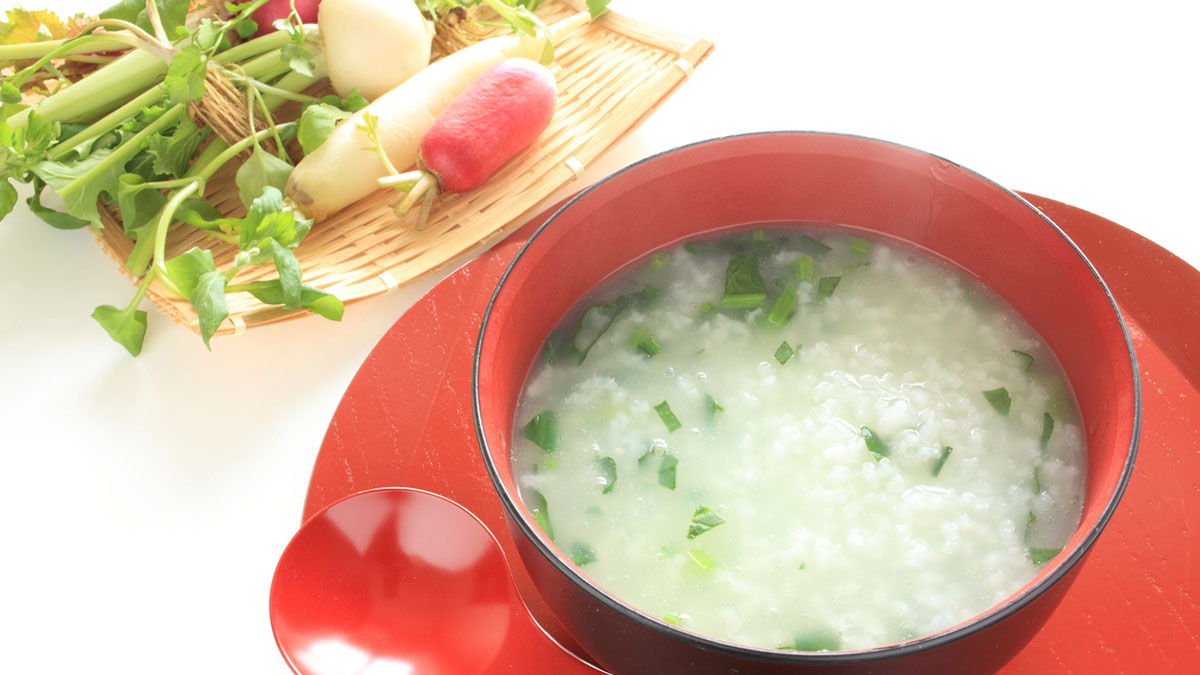日本文化を英語で説明しよう
お正月の終わり「七草粥」の意味や歴史
お正月の終わり7つの野菜の意味
を英語のフレーズで紹介しよう

1月7日、正月のご馳走をたらふく食べて疲れた胃に七草粥が染みますね。スーパーでは、三が日を過ぎると、七草がパックやフリーズドライで売られているのを目にします。なぜこの日に粥を食べるのか、粥にどんな意味があるのか…英語で説明できますか? 日本の文化を外国人に紹介するとき、役立つフレーズをコンパクトにまとめました。さっそく会話で役立ててみましょう。
What is Nanakusa gayu (rice porridge with seven herbs) ?
七草粥とはどんなもの?
The old custom called Nanakusa-gayu spread all over Japan in Edo era. In the morning of January 7th (the day called Jinjitsu no Sekku: one of the 5 seasonal festivals, which literally means person-day festival) people have salt taste rice porridge made by “spring seven wild herbs”.
1月7日(人日の節句:5節句のひとつで人を大切にする日)の朝に「春の七草」と呼ばれる具材を入れた塩味の粥を食べる七草粥の習慣は、江戸時代に日本各地に広まりました
But the origin of this custom is back to the ancient Chinese era called Tang. They had soup with 7 ingredients on the day of Jinjitsu no Sekku.
この習慣の起源は、中国の唐の時代にあり、人日の節句に7種類の具材の入った汁を飲む習慣に始まったようです
This custom has been brought to Japan in Heian era, and it connected with the ancient Japanese new year custom called “Wakana Tsumi” (nip off the shoots on new year day) and now is adopted in Japan and known as Nanakusa-gayu.
この習慣が日本へ伝わったのは平安時代と言われ、日本古来の正月に雪の下から新しい芽を摘んで食べる「若菜摘み」と結びついて七草粥の習慣となりました

What do you put in Nanakusa gayu?
七草粥には何を入れる?
Although they have different ingredients depending on regions, it has a common purpose, which is pray for purging noxious vapors and state of perfect health over the year.
七草粥に入っている具材は、地方によって違う場合もありますが、邪気を払い一年間の無病息災を祈って食べる点は、どの地方にも共通しています
You can use Tanka (31 syllables verse) rhythm in order to remember the 7 ingredients for Nanakusa-gayu.
七草粥に入れられる春の七草は5・7・5・7・7の短歌のリズムで覚えやすく口ずさんで覚えることができます。
Seri, Nazuna- Gogyo, Hakobera,Hotokenoza, Suzuna, Suzushiro
「せり、ナズナ、ゴギョウ、ハコベラ、ホトケノザ、スズナ、スズシロ」
Each ingredient has different kind of medical virtues such as nutritional enhancement and intestinal function. Also the herbs have the lucky charm meanings after the name.
それぞれの食材に滋養強壮や整腸作用などの効能があり、また名前になぞらえた縁起物の意味があります
Seri: (EN name) Water dropwort / Compete and win
セリ:競り勝つ
Nazuna (Penpen-gusa) : (EN name) Shepherd’s purse / wipe and remove the dirt
ナズナ(ペンペン草):撫でて汚れを取り去る
Gogyo: (EN name) Cudweed / Buddha’s body
ゴギョウ:仏の体
Hakobera : (EN name) Chickweed / Spread the prosperity
ハコベラ:繁栄がはびこる
Hotokenoza : (EN name) Henbit / Buddha’s seat
ホトケノザ:仏の座る場所
Suzuna : (EN name) Tunip / Bell for calling god
スズナ(かぶ):神を呼ぶ鈴
Suzushiro : (EN name) Daikon raddish / Pure white
スズシロ(大根):清らかな白
They cut those 7 ingredients at night of January 6th while singing the song called “Nanakusa Hayashi (seven herb music).
これら7つの食材を、1月6日の夜に「七草囃子」という歌を歌いながら刻んでいたそうです
Nowadays, it is not common to sing the song while cutting seven herbs.
But after January 3rd, we will often see the seven herbs set in the plastic pack, freeze-dry seven herb or even instant food of rice porridge with seven herbs.
現在では、歌を歌いながら七草を刻むことは一般的ではありません
しかし、お正月の3が日を過ぎると、スーパーでパックに入った七草セットやフリーズドライの七草、インスタントの七草粥も販売されているのを目にします

最近では食生活の変化や就業環境などから、1月7日に七草粥を食べない家庭も増えているようですが、七草粥を英語で説明しつつ、新年の間に疲れた胃腸の調子を整えることもできる健康食として、目を向けてみてはいかがでしょうか?
| ライタープロフィール●Cherie (シェリー) | |
 |
自動車をこよなく愛するCar Enthusiast(車バカ)。独学で英語・伊語のトリリンガルとなり、趣味はインスタグラムで海外の車バカのみなさんと語り合うこと。目標はルマン24時間耐久レースで取材活動をすることです。大学で歌舞伎を卒論テーマにしたり日本文化にも興味あり。 |



















